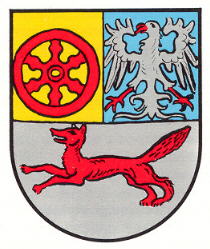Fussgönheim: Difference between revisions
Knorrepoes (talk | contribs) No edit summary |
Knorrepoes (talk | contribs) m (Text replace - "[[Literature" to "{{media}} [[Literature") |
||
| Line 20: | Line 20: | ||
The only known seal of the town dates from the 17<sup>th</sup> century and shows a canting foot (Fuss). | The only known seal of the town dates from the 17<sup>th</sup> century and shows a canting foot (Fuss). | ||
{{media}} | |||
[[Literature]] : Stadler, K. : Deutsche Wappen - Bundesrepublik Deutschland. Angelsachsen Verlag, 1964-1971, 8 volumes. | [[Literature]] : Stadler, K. : Deutsche Wappen - Bundesrepublik Deutschland. Angelsachsen Verlag, 1964-1971, 8 volumes. | ||
Revision as of 21:44, 8 July 2014
| Heraldry of the World Civic heraldry of Germany - Deutsche Wappen (Gemeindewappen/Kreiswappen) |
FUSSGÖNHEIM
State : Rheinland-Pfalz
District (Kreis) : Rhein-Pfalz-Kreis
Verbandsgemeinde : Verbandsgemeinde Maxdorf
Official blazon
Origin/meaning
The arms were officially granted in 1927 and show in the lower half a fox. The fox is a canting symbol for the old name of the village, Fuchsbach (fox-stream). The wheel is derived from the arms of the Lords of Bolanden, who ruled the village until around 1200. The eagle is derived from the arms of the Counts of Leiningen, who ruled the village from the 14th century until 1729.
The only known seal of the town dates from the 17th century and shows a canting foot (Fuss).
Contact and Support
Partners:
Your logo here ?
Contact us
© since 1995, Heraldry of the World, Ralf Hartemink 
Index of the site
Literature : Stadler, K. : Deutsche Wappen - Bundesrepublik Deutschland. Angelsachsen Verlag, 1964-1971, 8 volumes.











